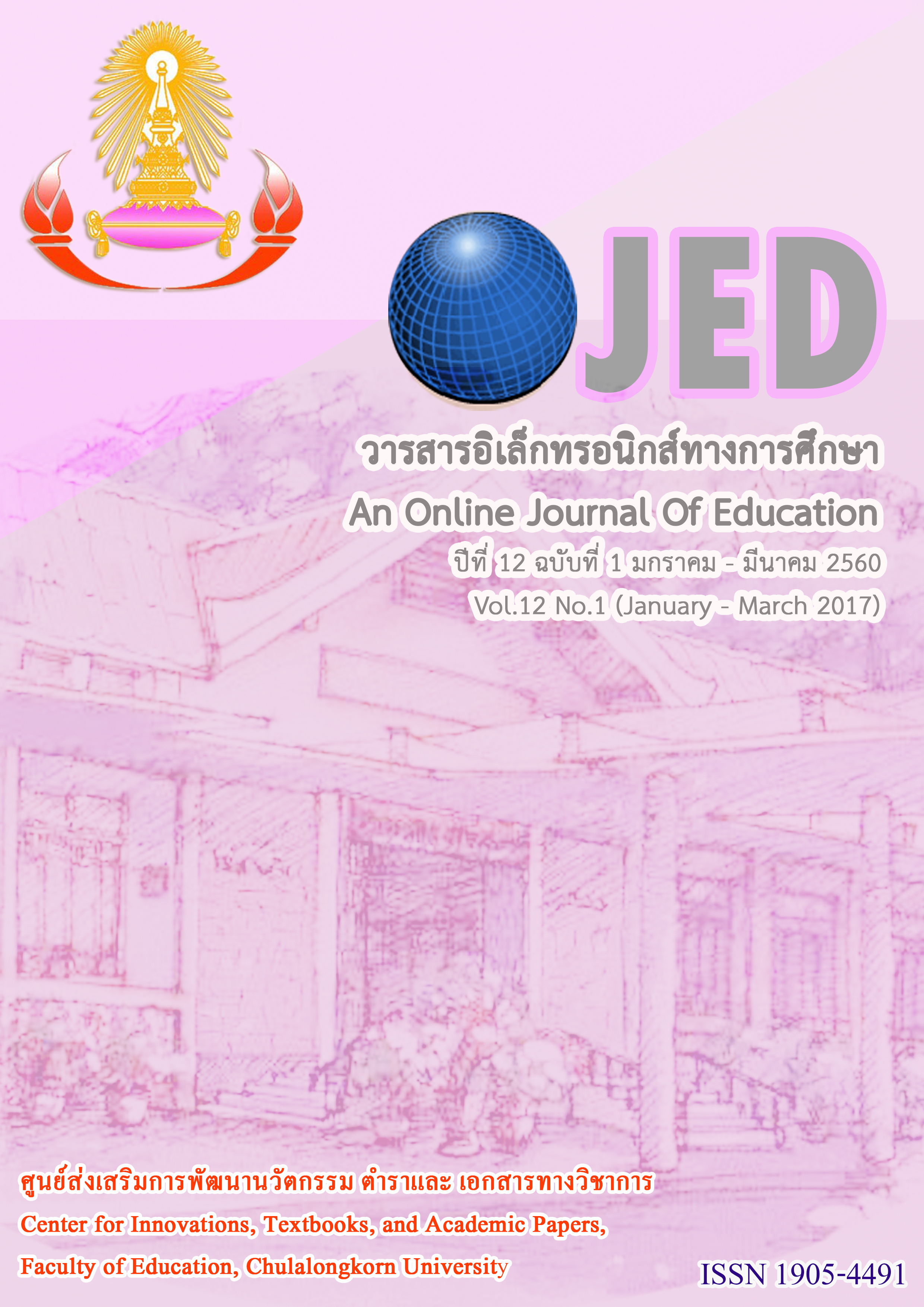การวิเคราะห์กลุ่มแฝงอัตลักษณ์เชิงวิชาชีพครู
Keywords:
อัตลักษณ์เชิงวิชาชีพครู, ครูไทย, การวิเคราะห์กลุ่มแฝง, TEACHERS’ PROFESSIONAL IDENTITY, THAI TEACHER, LATENT CLASS ANALYSISAbstract
การวิจัยครั้งนี้มีวัตถุประสงค์เพื่อ 1) วิเคราะห์องค์ประกอบ และตัวบ่งชี้อัตลักษณ์เชิงวิชาชีพครูของครูไทย 2) วิเคราะห์กลุ่มแฝงอัตลักษณ์
เชิงวิชาชีพครูของครูไทย การวิจัยครั้งนี้เป็นการวิจัยแบบผสมวิธี แบบลำดับเวลา แบ่งเป็น 2 ระยะ ระยะที่ 1 เป็นการวิจัยเชิงคุณภาพ เพื่อตรวจสอบความเหมาะสมขององค์ประกอบและตัวบ่งชี้อัตลักษณ์เชิงวิชาชีพครูของครูไทยในเบื้องต้น ด้วยการสัมภาษณ์นักวิชาการทางการศึกษา 14 คน เครื่องมือที่ใช้ในการวิจัย คือ แบบสัมภาษณ์ วิเคราะห์ข้อมูลโดยใช้การวิเคราะห์เนื้อหา ระยะที่ 2 เป็นการวิจัยเชิงปริมาณ ตัวอย่างวิจัย คือ ครูสังกัดสำนักงานคณะกรรมการการศึกษาขั้นพื้นฐาน (สพฐ.) 625 คน เครื่องมือที่ใช้ในการวิจัย คือ 1) แบบสอบถาม โดยผ่านการตรวจสอบความตรงเชิงเนื้อหา มีค่า ความสอดคล้องระหว่างข้อคำถามและวัตถุประสงค์อยู่ระหว่าง 0.57 ถึง 1.00 และมีค่าความเที่ยงอยู่ระหว่าง 0.601 ถึง 0.958 และ 2) แบบสอบวัดความรู้ในการประกอบวิชาชีพครู โดยผ่านการตรวจสอบความตรงเชิงเนื้อหา มีค่าความสอดคล้องระหว่างข้อคำถามและวัตถุประสงค์อยู่ระหว่าง 0.57 ถึง 1.00 มีค่าความยากอยู่ระหว่าง 0.211 ถึง 0.789 มีค่าอำนาจจำแนกอยู่ระหว่าง 0.235 ถึง 0.824 และมีค่าความเที่ยงแบบ KR20 ท่ากับ 0.741 การวิเคราะห์ข้อมูล ประกอบด้วย การวิเคราะห์องค์ประกอบเชิงยืนยัน และการวิเคราะห์กลุ่มแฝง
ผลการวิจัยที่สำคัญสรุปได้ดังนี้ 1. อัตลักษณ์เชิงวิชาชีพครู ประกอบด้วย 3 องค์ประกอบ 26 ตัวบ่งชี้ ดังนี้ องค์ประกอบที่ 1 ความรู้
ในการประกอบวิชาชีพครู ประกอบด้วย 10 ตัวบ่งชี้ องค์ประกอบที่ 2 ความสามารถในการประกอบวิชาชีพครู ประกอบด้วย 9 ตัวบ่งชี้ และองค์ประกอบที่ 3 คุณธรรม จริยธรรม และจรรยาบรรณวิชาชีพ ประกอบด้วย 7 ตัวบ่งชี้ โมเดลอัตลักษณ์เชิงวิชาชีพครู ซึ่งประกอบด้วย 3 องค์ประกอบ และ 26 ตัวบ่งชี้ดังกล่าว มีความสอดคล้องกลมกลืนกับข้อมูลเชิงประจักษ์ (Chi-square = 183.745, df = 188, p = 0.574, GFI = 0.978, AGFI = 0.959 และ RMR = 0.019) 2. การวิเคราะห์กลุ่มแฝงอัตลักษณ์เชิงวิชาชีพครูโดยภาพรวม พบว่าสามารถจำแนกครูได้เป็น 3 กลุ่ม ได้แก่ กลุ่มที่ 1 คือกลุ่มครูที่ไม่มีอัตลักษณ์เชิงวิชาชีพครู จำนวน 35 คน (ร้อยละ 5.60) กลุ่มที่ 2 คือ กลุ่มครูที่มีความรู้ และคุณธรรมประจำใจในการประกอบวิชาชีพครูต่ำ จำนวน 429 คน (ร้อยละ 68.64) และกลุ่มที่ 3 คือ กลุ่มครูที่มีความรู้ในการประกอบวิชาชีพครูต่ำ จำนวน 161 คน (ร้อยละ 25.76) จากจำนวนครูทั้งหมด 625 คน
The purposes of this study were 1) to analyze the components and indicators of the professional identity of Thai teachers, and
2) to analyze the latent class of the professional identity of Thai teachers. This study employed an exploratory sequential mixed-methods research design. The study was divided into two phases. Phase 1 sought to validate factors and indicators of the professional identity of Thai teachers by collecting data from 14 educational experts via interviews. The data were analyzed by content analysis. Phase 2 was a quantitative study collecting data from 625 teachers in OBEC schools. The research instruments included 1) questionnaires with Item-Objective Congruence (IOC) scores 0.57-1.00 and reliability coefficients of 0.601-0.958; and 2) teachers’ profession knowledge tests with IOC scores of 0.57-1.00, difficulty levels of 0.211-0.789, discrimination levels of 0.235-0.824, and the KR20 for a reliability coefficient of 0.741. Methods used to analyze the data included confirmatory factor analysis and latent class analysis.
The research results were as follows: 1. Teachers’ professional identities consisted of 3 factors covering 26 indicators: Factor 1 is the knowledge of the teacher’s profession measured by 10 indicators; Factor 2 is the ability of the teacher’s profession measured by 9 indicators; Factor 3 is the morals of the teacher’s profession measured by 7 indicators. The structural model of teachers’ professional identities fit well with the empirical data (Chi-square = 183.745, df = 188, p = 0.574, GFI = 0.978, AGFI = 0.959 and RMR = 0.019) 2. The latent class analysis of teacher’s professional identitities classified Thai teachers into three classes: Class 1 consisted of 35 teachers (5.60%) who were without teacher’s profession, Class 2 consisted of 29 teachers (68.64%) whose levels of knowledge and the morals of teachers were low, and Class 3 consisted of 161 teachers (25.76%) whose level of knowledge of teachers’ profession was low




